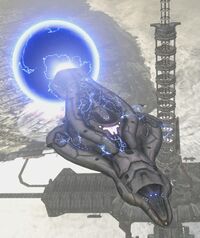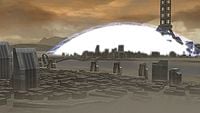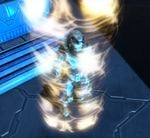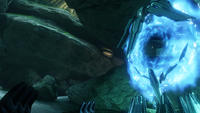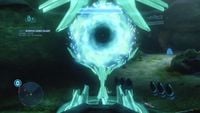Slipstream space
From Halopedia, the Halo wiki
Slipstream space,[1] colloquially known as slipspace,[2] or the Slipstream[3] and formally known as Shaw-Fujikawa space[4] or subspace[5] by the United Nations Space Command, is a collective term for the eleven non-visible infinitesimal dimensions used for faster-than-light travel.[6] Making a transition from one place to another via slipspace is known as a "slip", or "jump". A device which allows a spacecraft to perform slipspace transitions is generally referred to as a slipspace drive.
Background
Slipstream space is a specific set of eleven dimensions existing in a very small bundle.[6][7] While these dimensions are present in normal space, they do not have an effect on the physics of normal space. By moving matter from the three 'normal' space dimensions to slipstream space, one effectively changes the laws of physics for that piece of matter. This allows faster-than-light travel without relativistic side-effects i.e., the occupants do not "warp" time, despite their superluminal speed.
To the human eye, slipspace appears pitch black, because there is nothing in the visible spectrum to see.[2][8][note 1]
It is likely that the theory of slipstream space existed prior to 2291, however in that year, Tobias Shaw and Wallace Fujikawa were the first humans to successfully implement a device that could transition normal matter into slipstream space, the Shaw-Fujikawa Translight Engine.
The Covenant utilizes the same eleven dimensions of slipstream space for travel, though the means they use to make the transition are more sophisticated than those used by humans, as evidenced by their markedly faster journeys from point to point.
The Forerunners had a far greater understanding of slipstream space, with the abilities to travel nearly instantaneously over galactic distances, transport massive objects through the use of portals, to disrupt slipstream travel from normal space and track slipspace jumps across the galaxy. In addition, they had developed a great variety of other applications, often involving the manipulation of time and space within a slipspace field.
Mechanics
Slipspace is a tangle of intertwined spatial dimensions, comparably similar to a wadded up piece of paper, which lie underneath the three conventional spatial dimensions of the universe; rather like taking the classic "flat sheet" used to represent gravity and crumpling it up into a ball, thereby creating extra dimensions and shorter spaces between points. Slipspace can be thought of as the detectable universe, (which, technically, it is), but with a greater number of dimensions. Our plane of existence is thought to have four dimensions (up-down, front-back, side-to-side and time), but slipspace is an eleven-dimensional spacetime.[6]
The slipstream also possesses different laws of physics than our "normal" universe, although some basic ones, such as energy transfer and momentum, remain the same.[9] Due to the different laws of physics in the slipstream, times, masses, positions or velocities in slipspace are impossible to accurately measure based on the standards of normal space.[3]
Slipspace is not completely empty; clouds of primordial atomic hydrogen are relatively frequent. Occasionally, even comets are known to somehow find their way into slipspace.[3] Objects close to one another such as fleets often group together in mass slipspace transit and may appear to sensors as a large, singular object.[10] An object in slipspace can pass through a mass, such as a planet, without causing a collision in normal space; such an event may often go completely unnoticed.[10] However, there may be risks involved if a ship is still early in slipspace transit and passes through a large object, such as another ship.[11]
Time dilation

The time slipspace travel takes to normal-space observers varies substantially - one cannot depend on the same amount of time passing in slipstream space and normal space. With human slipspace travel, there is generally a five to ten percent variance in travel times between stars. A fleet that transitions to slipstream space at the same time may or may not transition back to normal space at the same time. Furthermore, if ship 'A' and ship 'B' both were to enter slipstream space at the same time and exit at the same time, the crew on ship 'A' could have experienced a longer journey subjectively, and the crew of ship 'A' could be a week older than that of ship 'B' despite appearances in normal space. Though no human scientist is sure why travel time between stars is not constant, many theorize that there are "eddies" or "currents" within the slipstream. This temporal inconsistency has given military tacticians and strategists fits, hampering an uncounted number of coordinated attacks.[12]
The relativistic side-effects of slipspace travel are normally eliminated by a process known as causal reconciliation,[13] or particle reconciliation.[14] This effect is briefly experienced once the ship returns to normal space, and manifests as a shimmering blue glow radiating out of the ship[15] and static electricity building up in the occupants' bodies.[13] With longer jumps, the effects of reconciliation are clearly noticeable for several seconds upon returning to normal space.[16] However, the range for causal reconciliation is limited. If a ship performs a significantly long jump, time dilation effects may be experienced.[14] With shorter jumps like those typically performed by human ships, the effects experienced by the occupants are negligible.
In addition, there is a "bandwidth" for the amount of things going through slipstream space at once. This effect is noticeable if immense amounts of mass are transported over large distances frequently, making slipspace travel throughout the galaxy move more slowly and journeys require more individual jumps to complete.[17] This was seen when Master Builder Faber used slipspace portals to transport the Halo Array.[18]
Drive operation
The Shaw-Fujikawa Translight Engine generates a resonance field, which when coupled with the unusual physics of the slipstream, allows for dramatically shorter transit times between stars. UNSC slipspace drives use particle accelerators to rip apart normal space-time by generating micro black holes. These holes are evaporated via Hawking radiation in nanoseconds. The real quantum mechanical marvel of the drive lies in how it manipulates these holes in space-time, squeezing vessels weighing thousands of tons into slipspace.[19] It must be noted that the Shaw-Fujikawa Translight Engine itself provides no motive power, and ships equipped with such a device still require conventional engines in order to move.[20]
Starships and their occupants are not directly exposed to the eleven-dimensional space-time while moving through slipspace; instead, the ship is enveloped in a quantum field generated by the drive. The field acts as a medium between the ship and the higher dimensions, translating its presence as a normal-space object to the arcane physics of slipspace and enabling it to "squeeze through" the higher dimensions.[21] This field requires an enormous amount of constant calculations to maintain, with the number of needed calculations increasing with the size of the ship. For example, the slipspace translations for a Phoenix-class colony ship require 4.3 quadrillion calculations of the quantum field per second.[22]
Before jumping into slipspace, human ships must first reach a Safe Slipspace Entry Point, or SSEP, where it can be ensured they will not drag anything from normal space into the slipstream as the ship initiates the transition.[23] In addition, star systems have specific slipstream space transfer points known as "interstellar jump points", or IJPs, locations designated ideal for initiating a slipspace transition.[24]
The Covenant have a very finely tuned version of slipspace technology, far superior to the human Shaw-Fujikawa Translight Engine. Instead of simply tearing a hole into slipspace, Covenant slipspace drives cut a very fine hole in the fabric of space-time and slips into slipspace with precision, much like a scalpel compared to a butcher knife. It exits with the same pinpoint accuracy, takes less time during travel, and is able to plot a course with error not exceeding an atom. This is why in battle Covenant ships are able to slip by human defenses by using slipspace.[25] It has also been theorized by the UNSC that Covenant drives generate several 'microjumps' within a single slipspace transition to measure dilation, allowing them to reach their destinations faster.[26] Standard Covenant tactics include using short slipstream jumps to gain positional advantage and surprise other ships, in addition to avoiding incoming ordnance. The Covenant's superiority in drive technology, combined with differing weapon and shield technology, allows a small number of Covenant ships to effectively engage a much larger UNSC force. Missiles, especially, can be defeated by a brief slipstream jump, as they cannot track through slipstream space.
The plotting of slipspace jumps is known as astrogation, and is typically performed by a navigation computer or an AI,[27] although humans are capable of conducting at least some of the calculations involved.[28]
In addition to having to deal with temporal anomalies, UNSC ships are not able to jump with exact precision. A ship may transition back to normal space millions of kilometers from its intended destination.[29] As a result, UNSC ships often transition in and out of slipspace far from any gravity wells of celestial bodies. In-system jumps are also generally considered impractical, even dangerous, by the UNSC due to this lack of precision.[30] A notable exception of this is during the Battle of Psi Serpentis, when the Battle Group India, under command of Admiral Preston Cole, performed an in-system jump. Even though Cole had made thorough calculations for the jump a week in advance and guidance beacons were used as navigational assists, a part of the battle group scattered, reappearing outside the main group.[31]
The Gravemind was able to use the UNSC In Amber Clad to make a successful precision jump into High Charity. This may be due to an improvement on the ship due to the recent capture of Covenant Slipspace technology, the Gravemind adjusting it or possibly using Installation 05's teleportation grid or related systems to move the ship.[32] Cortana was able to jump the Covenant flagship Ascendant Justice into slipspace inside the atmosphere of the gas giant Threshold following the Battle of Installation 04, a feat previously thought impossible even by the Covenant.[33] Following the Human-Covenant War, a number of UNSC ships, such as the UNSC Infinity, have been fitted with Forerunner drive technology, granting them near-perfect jump accuracy in addition to far greater velocities.[34]
Gravitational effects
Although they are not present as tangible objects within slipspace, the gravitational pull of large masses, such as stars, affects the geometric trajectory of objects traveling in slipspace much like it would in normal space. This effect typically distorts and scatters clouds of dust drifting in the Slipstream.[10]
Gravitational fields of significant size, such as those generated by a planet, affect the superfine quantum filaments that a slipspace drive must use to calculate an entry point to the slipstream, and UNSC calculations are unable to offset this effect.[35] Covenant drives, in turn derived from Forerunner technology, have a much higher resolution of the filaments, and use more accurate calculations, and though the Covenant do not use this ability, are capable of making slipstream transition in and out of a planet's gravity well. Indeed, while using the captured Ascendant Justice to make a slipspace jump within Threshold's atmosphere, Cortana remarked that "It was as if she was blind before."[35] After observing this innovation, a Covenant AI managed to leak the data out to the rest of the Covenant in a transmission. During the Battle of Mombasa, the Prophet of Regret used this newfound knowledge to transition into slipspace while directly over New Mombasa in Earth's gravity well, damaging the city and causing the weakening and eventual collapse of the orbital elevator there.[36] These events show that, while the Covenant often cannot innovate their own solutions, they are quick to adopt any practice that increases their combat prowess.
Velocities

Because the slipspace drive itself does not generate thrust (instead maintaining the ship's quantum field and transitioning it in and out of slipspace), a ship must still rely on acceleration provided by its conventional drive engines while in slipspace.[20] As a result, ships which are faster in normal space due to their more powerful thruster engines and proportionally small mass, such as corvettes, usually travel faster in the Slipstream as well.[37] The mechanics of the slipspace drive and the way it manipulates the slipspace field also affect a ship's velocity, with more sophisticated drive technology allowing for various methods of crossing distances more efficiently.[25][26] Frequent traffic, especially when moving objects of considerable mass, will also slow slipspace traffic down on a galactic scale, although this is only known to have occurred when the Forerunners moved the Halo installations across the galaxy.[17]
However fast it may appear, human faster-than-light travel is by no means instantaneous; "short" jumps routinely take up to two months, and "long" jumps can last six months or more for the crew. Certain UNSC ships are known to be able to travel at a speed of 2.625 light years per day,[note 2] while Covenant ships can reach 912 light years per day.[note 3] After the end of the Human-Covenant War, the discovery and reverse-engineering of Forerunner technologies allowed humanity to achieve significantly greater velocities; by January 2553, the UNSC Port Stanley was equipped with an upgraded drive which enabled the ship to cross interstellar distances in mere hours.[38]
One example of the differences between speeds is comparing the Covenant cruiser Ascendant Justice with the UNSC Halcyon-class cruiser UNSC Pillar of Autumn. It took several weeks for the Pillar of Autumn to get from Reach to Installation 04, yet the Ascendant Justice could get from Installation 04 to Reach within thirteen hours from the occupants' frame of reference. However, this may have been due to the influence of the Forerunner crystal, which simultaneously caused the Ascendant Justice to go back in time for several days as a result of its occupants being on an event path intersecting the crystal.[39]
Though the Covenant use a modified version of Forerunner systems, true unaltered Forerunner slipspace technology was first observed in the form of the Portal transporting UNSC and Covenant vessels from Earth to The Ark, transporting them hundreds of thousands of light years within a month.[note 4] Additionally, while a Covenant assault carrier could reach Delta Halo from Earth in thirteen days, the Forerunner Dreadnought took only five days to travel the same distance. Given the fact that Covenant understanding of Forerunner technology is comparatively primitive, the ship may have been capable of much higher velocities. This is very likely as the Mantle's Approach was able to travel from the vicinity of Installation 03 to Earth in a matter of minutes.
Dangers and risks
Slipspace travel is dangerous due to the high level of radiation encountered during the trip, which can be extremely hazardous to the crew. This is negated by the use of lead foil in UNSC ships, which absorbs the radiation. Fissile materials also emit radiation, specifically Čerenkov radiation, emitted when particles travel through a medium at a faster rate than light travels in that same medium upon exiting Slipspace; this is not harmful to humans, however it does make emerging from Slipspace very noticeable. It is not known how the Covenant deal with radiation, but it is presumed that either they also utilize a shielding material, or with their improved slipspace technology and energy shielding, it does not affect them at all.[40] In addition, slipspace travel generates a great deal of static electricity on the ship's hull. To discharge the static energy, humans have developed a piezoelectric material known as polymerized lithium niobocene.[41]
Direct exposure to the Slipstream is incredibly dangerous. Despite the presence of a quantum field which effectively keeps the ship within a "bubble" of normal space,[21] people traveling on a slipspace-capable craft can experience a range of symptoms, from nausea, to heart failure or even death. Even more uncommon, but still known to happen, is the total disappearance of a person while in the slipstream.[42] In some rare cases, having a specific reality-manipulating object such as the Forerunner crystal aboard has caused a ship to enter an anomalous slipspace dimension different from the normal slipspace used for travel.
Since the Slipstream is constantly shifting, and its laws of physics are different to our own, the magnetic coils of Slipspace drives drift out of phase when entering and leaving a Slipspace field, requiring constant maintenance. During the 2490's, technicians had to manually repair Slipspace drives, exposing themselves to the Slipstream and occasionally suffering injury, death or simply disappearing.[43] Mechanical failures like Slip Termination, Preventable, or STP, can also occur with Slipspace drives, usually resulting from poor maintenance.[44] An improperly mounted Slipspace drive can also result in catastrophic accidents, as was the case with a colony ship en route to the Cygnus system in the mid-2550's: as a result of a maintenance failure, the drive tore the ship apart, transporting half of it into an unknown location. During the Fall of Reach, the UNSC intentionally recreated the conditions of this accident to destroy a Covenant supercarrier.[45]
Prior to 2552, entering slipspace from the gravity well of a planet had never been attempted, either by the UNSC or the Covenant. The effect of gravity upon the creation of a slipspace entrance usually collapsed UNSC-generated holes, and was assumed to be the same with Covenant technology. The flagship Ascendant Justice, however, was able to escape from a gas giant's gravity well after Cortana realized that it had a far higher resolution of the quantum filaments that allowed a transition, and she was able to compensate for the gravity. Subsequently, the ability was transmitted by a Covenant AI, and the Prophet of Regret used an in-atmosphere slipspace jump to escape Earth, with the resulting shockwave dealing devastating damage to the city of New Mombasa. Slipspace jumping inside an atmosphere, however, is extremely dangerous to the surrounding people and objects. When a ship transitions into normal space in-atmosphere, the air that was there is pushed aside, causing a massive shockwave centered at the ship. If a ship transitions to Slipstream space inside an atmosphere, on the other hand, it leaves an empty space that air quickly rushes to fill, causing an implosion. Exiting slipspace in-atmosphere is generally far less destructive than entering it, as ships have done so numerous times without disastrous effects.
Entering and exiting the slipstream is normally only attempted by ships of large mass, their gravity wells stabilizing the constantly fluctuating slipspace to a degree that allows safe passage.[46] Small ships, such as dropships, do not possess the same gravity and are placed under considerably more stress than a warship, able to crack the hull and buckle reinforcing struts.[47] It is not impossible, and UNSC slipstream monitoring probes make the transitions all the time, but require heavy reinforcement to survive the stresses, and are unmanned, having no need to protect internal occupants.[46] Specialized craft like Long Range Stealth Orbital Insertion Pods can make the transition, but are still an extremely uncomfortable ride.[48] A Slipspace-to-normal space transition has been successfully attempted by a Spirit dropship, but it had been extensively equipped with Titanium-A battleplates, lead, and carbon-molybdenum steel I-beams.
Even the Forerunners had potential dangers when traveling through slipspace. During the assault on the Capital by Mendicant Bias, seven of the twelve original Halo rings in existence at the time attempted to flee using a slipspace portal. Only one of them, along with Bornstellar Makes Eternal Lasting's ship made it through. The rest were destroyed when the slipspace portal closed due to the stress of the Halo installations passing through. The enormous amount of mass passing through simultaneously also put massive strain on the slipspace portal, causing any occupants to be dangerously exposed to the foreign physics of slipspace. This resulted in causal reconciliation effects far more severe than normal, as well as symptoms involving the loss of perception of reality and time, massive amounts of electrical charge, and even perceived lack of solidity.[13] After such an event, a slipspace channel may not return to a stable state for years.[49]
Slipspace wake
A "Slipspace wake" is a phenomenon occurring for some time after a ship has made a slipspace transition. When another, slower ship encounters a slipspace wake, they will be pushed to the speed of the ship that left the wake, thus propelling them through Slipspace at the same velocity. The UNSC Dusk took two weeks to get to Installation 05 via the Solemn Penance's weakening "wake",[50] but came back to Earth within hours by following the Forerunner Dreadnought's wake.[note 5] The crew of the Dusk later exploited the Bloodied Spirit's outbound wake to get to Onyx, thirty-eight light years away, within an hour.
Anomalies
- Main article: Slipspace anomaly
In rare cases, various types of anomalous phenomena occur in slipspace. These may be caused by specific artifacts or devices. The effects of these anomalies are diverse, but often harmful. The Forerunner crystal found on Reach was capable of creating a distortion in Slipspace, but it also made massive amounts of radiation.
Application
Communications
The Forerunners were capable of creating advanced message carrier waves in slipspace. This way, messages and memorandums could travel at great speeds throughout the Forerunner ecumene. Cortana was able to use this technology to declare codes Bandersnatch and Hydra during the Battle of Installation 05 in close-knitted timing and symmetry.[51] The Forerunners also used a type of quantum entanglement for communication, although it is unknown whether this is related to the aforementioned carrier wave system. These communications were routed over proprietary encryption protocols, which could be used to track the source or destination of the communication.[52]
By 2531, the UNSC was known to use a form of radio signal carried via slipspace for interstellar communication. After the onset of the war with the Covenant, Admiral Preston Cole recommended ONI to begin obfuscating these signals to prevent the Covenant from triangulating the source.[53] As of July 2552, humanity had successfully developed superluminal communications technology which allows interstellar communication in real-time.[note 6] How this technology functions, or what its limits are, has not been specified. This system may operate in a similar fashion to a form of communication known as "slipstream packets", which are, in essence, recorded audio messages, rather like letters. Human civilians were able to use slipstream packets by September 2552.[54][55] These messages are sent through Waypoint, a service which utilizes the UNSC's communications network.[56] UNSC emergency locator beacons also appear to be able to send an emergency signal at FTL speeds.[57]
Before the advent of superluminal communications, most human long-range communiques were carried on the shipboard memory of starships such as automated freighters. On the other end of the ship's slipspace journey, the message would be relayed to the intended recipient.[58]
The UNSC also developed a piece of technology known as the Slipspace COM launcher, which sent independently guided probes through slipspace as fast as any UNSC starship. However, this technology was highly expensive and as a result there were only three such launchers in existence by 2552: one on Reach, one on Onyx and one on Earth. As of the conclusion of the Human-Covenant War, both the devices on Reach and Onyx have been destroyed, with the fate of the Earth device unknown.[59]
Teleportation
- Main article: Slipspace translocation
Slipspace can also serve as means of virtually instantaneous transport over short distances. Originally developed by the Forerunners, Slipspace translocation technology allows its user to safely pass between two locations by enveloping the user in a Slipspace field and transporting them to the intended destination.[60] The Forerunners utilized this technology to a great effect, using it in teleportation grids and transportation pads encountered on many of their installations. Later, the Covenant also adopted this technology and are known to have used it in their gravity thrones and spires.
AI housing
A possible application of slipspace is the use of its eleven-dimensional space-time as housing space for "smart" artificial intelligence constructs, in a purely abstract fractal constructed within the slipstream. This would grant AIs complete independence from physical systems and give them unlimited room for extended cross-linkages – by extension, making them virtually immortal, free from the limitations of a Riemann matrix, which normally cause a smart AI to terminate either abruptly due to a "short circuit", or in more drawn-out process known as rampancy. So far, this has only been attempted once, by Dr. Catherine Halsey in an unsanctioned experiment in 2547. Though the experiment was a failure, the AIs of the Assembly recognized it as a viable means of gaining permanent independence from their creators.[61][7]
Forerunner applications
The Forerunners had developed a great deal of applications for the slipstream. These included the ability to create bubbles of slipstream space, in which the flow of time could be manipulated or stopped altogether while keeping the contents of the bubble either visible or invisible in normal space. The Forerunners were also capable of containing these bubbles of alternate space-time within one another.[62] These bubbles could be used to store considerable masses and volumes in slipspace stably for thousands of years and potentially for all of time, and to transition matter from normal space to the inside of a construct in slipstream space without requiring the construct to transition back to normal space. The same technology was utilized in slipspace field pods that were essentially a Forerunner equivalent of cryo-chambers, effectively preserving a living organism inside a slipspace field. Slipspace bubbles were also employed in a type of Forerunner prison cell in which the passage of time could be manipulated so that a period of a billion years would pass inside the field, while only seconds had transpired in normal space.[63]
In addition, the Forerunners had the ability to construct weapon systems that could fire into slipspace and affect targets in normal space or within slipspace. This is demonstrated by the galaxy-wide effects of the Halo Array, as well as in smaller scale by the line installations.[57] The Forerunners were also able to send several objects into slipspace and have them exit in different locations through the use of a highly sophisticated network of slipspace portals.[64] The Forerunners were also capable of anchoring objects in normal space into place via slipspace conduits, as shown when the UNSC Infinity was constrained over Requiem by an array of slipspace artifacts.[65]
Similarities
Slipspace fills a common niche found in most space science fiction series/films, allowing ships to travel vast distances in a small amount of time, allowing convenient travel through the galaxy. Though other series use different methods, it is most similar to hyperdrives, which similarly burrow into other (albeit more stable) dimensions where faster than light (FTL) travel without the relativistic side effects is possible. Other series use different methods, allowing actual FTL travel in normal space, or instantaneous teleportation, but the principles still follow a similar trend.
Slipspace can be likened to the discovery of matterwave transport without transit. In this process, all seven hidden spatial dimensions, three known spatial dimensions and two time dimensions appear to collapse into a singularity to an outside observer. But in reality, this is only an illusion. In this type of field, relativity predominates, for instance the reality is dependent on the radial displacement from the source that generates the field. At small distances, reality is relatively intact. The further away from the field source, the less sense it makes to talk about reality; a cause can occur after an effect, time has no linear flow. Nothing has a definite momentum or velocity. Objects can occur at multiple positions simultaneously. When an object enters a field, it produces a burst of neutrinos, antimatter and other types of radiation. Slipspace is also similar to a controversial theory known as the Heim Theory.
Gallery
Another view of a micro slipspace portal at the Apex location.
A micro slipspace portal on Requiem.
Cortana opens a micro slipspace portal on Requiem.
List of appearances
Notes
- ^ Halo Wars: Genesis depicts slipspace as resembling purplish nebulae. Halo: Fall of Reach - Boot Camp depicts it as a bluish-white tunnel of lines and quadrilateral figures. Halo 4 depicts it as a multicolored expanse. These are artistic liberties for the sake of presentation.
- ^ In Halo: First Strike, Lieutenant Wagner's prowler traveled from Reach to Earth - a distance of 10.5 light years - in four days. Velocity=Distance/time (V=10.5 light years/4 days=2.625 l/d)
- ^ In Halo: Ghosts of Onyx, the Covenant destroyer Bloodied Spirit travels from Earth to Onyx within a single day. The distance from Sol to Zeta Doradus is 38 light years. Velocity=Distance/time (V=38 light years/1 hour=38 l/h or 912 l/d)
- ^ The Sol system is located between 25 and 28,000 lightyears from the galactic centre, while the Ark is "218"ly from it (262096ly). If the Earth was at its nearest to the Ark (that is, 28,000ly away from the centre and on the Ark's side of the galaxy), it would be 234,096ly away - at its furthest it would be 290,096ly away. It should be noted that the Ark had been used by Forerunner dreadnought shortly beforehand; its wake could exaggerate the velocities within the slipspace portal.
- ^ It is never directly stated that the wake the Dusk followed was left by the Forerunner Dreadnought; however, it is implied on page 289: "The Dusk's journey back to Earth had occurred in record time. They had caught a wake in slipstream space, one indeterminably larger than the Covenant wake they had followed." This creates an inconsistency with later canon, such as this timeline, which reveals that the Dreadnought took five days to reach the Sol system and another nine days to reach Earth, instead of a few hours. Therefore, the Dusk's speedy return to Earth may have been the result of a Slipspace anomaly.
- ^ In Halo: The Fall of Reach Chapter 16, Captain Keyes contacts Admiral Stanforth from the Sigma Octanus system on a FLEETCOM priority channel and they have a real-time exchange. Stanforth is implied to be in a different system at the time. In addition, in her journal, Halsey receives an after-action report of the Battle of Sigma Octanus IV on July 18, 2552, the same day the battle took place. This would be impossible without a near-instantaneous communications system, as a ship could not have possibly traveled from Sigma Octanus system to Reach in a matter of hours; it took two weeks for Battle Group Leviathan to make the journey. Furthermore, according to page 122 of the Halo Graphic Novel, some sort of superluminal communications system was used by Dr. Catherine Halsey to contact Earth while onboard the Template:UNSCship. The transcript seems to show Halsey transmitting commands in real time. Even if this is accomplished using a script, it still takes about 36 minutes for the data to be transmitted from Earth to somewhere near Eridanus Secundus. The log in the Graphic Novel has an opening timestamp of 04:16 on September 12th, 2552; chapter 27 of Halo: First Strike opens at 04:50 on September 12th, at which point the data has apparently been received. The distance is unknown, however, and so the exact speed can not be calculated. Further examples of instantaneous superluminal communication are seen in the Data Drops.
Sources
- ^ Halo: The Fall of Reach, page 13
- ^ a b Halo: The Fall of Reach, page 15
- ^ a b c Halo: The Fall of Reach, page 136
- ^ Halo: the Fall of Reach, page 141
- ^ Halo: Combat Evolved, campaign level The Pillar of Autumn opening cinematic
- ^ a b c Halo: First Strike, page 87
- ^ a b Halo: Reach, Dr. Halsey's personal journal
- ^ Halo: Ghosts of Onyx, page 288
- ^ Halo: Ghosts of Onyx, page 55
- ^ a b c Halo: the Fall of Reach, page 137
- ^ Halo: Cryptum, page 99
- ^ Halo.Xbox.com - Halo Timeline
- ^ a b c Halo: Cryptum, page 322
- ^ a b Halo: Cryptum, page 135
- ^ Halo: Cryptum, page 312
- ^ Halo: Cryptum, pages 100, 135, 266
- ^ a b Halo: Cryptum, page 266
- ^ Halo: Cryptum, page 223
- ^ Halo: Ghosts of Onyx, page 53
- ^ a b Halo: Contact Harvest, Chapter 1, page 23
- ^ a b Dr. Halsey's personal journal, December 25, 2534
- ^ Halo Wars: Genesis
- ^ Halo: Contact Harvest, page 34
- ^ Bungie.net - Halo: Reach Project Page
- ^ a b Halo: First Strike, page 86
- ^ a b Halo: First Strike (2010), Tug o' War
- ^ Halo: Contact Harvest, page 96
- ^ Halo: Evolutions - Essential Tales of the Halo Universe, "The Impossible Life and the Possible Death of Preston J. Cole", page 426
- ^ Halo: The Fall of Reach, page 136
- ^ Halo: The Fall of Reach, page 104
- ^ Halo: Evolutions - Essential Tales of the Halo Universe, "The Impossible Life and the Possible Death of Preston J. Cole", page 477
- ^ Halo 2, campaign level Gravemind
- ^ Halo: First Strike, pages 80, 87
- ^ Halo: The Thursday War, page 247
- ^ a b Halo: First Strike, page 85
- ^ Halo 2, campaign level Metropolis
- ^ Halo: Ghosts of Onyx, page 187
- '^ Halo: Glasslands, page 68
- ^ Halo: First Strike, pages 247-248 (2003 edition)
- ^ Halo: Ghosts of Onyx, page 13
- ^ Dr. Halsey's personal journal, July 30, 2511
- ^ Halo: Contact Harvest, page 175
- ^ Halo: Ghosts of Onyx, page 146
- ^ Halo: Contact Harvest, page 24
- ^ Halo: Reach, campaign level Long Night of Solace
- ^ a b Halo: First Strike, page 289
- ^ Halo: First Strike, page 296
- ^ Halo: Ghosts of Onyx, page 13
- ^ Halo: Cryptum, page 341
- ^ Halo: Ghosts of Onyx, Chapter 22, page 186
- ^ Halo: Ghosts of Onyx, page 182-183
- ^ Halo: Cryptum, page 125
- ^ Halo: Evolutions - Essential Tales of the Halo Universe, "The Impossible Life and the Possible Death of Preston J. Cole", page 469
- ^ i love bees: week6_subject3.wav
- ^ Axon Clips: Chapter 6
- ^ YouTube: Halo: From A to Z with Frank O'Connor
- ^ a b Halo: Blood Line - Issue 1
- ^ Halo: Contact Harvest, page 35
- ^ Halo: Ghosts of Onyx, page 176
- ^ Halo: Ghosts of Onyx, pages 311-212
- ^ Halo: Reach, Data pad 17
- ^ Halo: Glasslands, pages 306, 311
- ^ Halo: Primordium, page 366
- ^ Halo Legends: Origins
- ^ Spartan Ops, S1E8 Expendable



